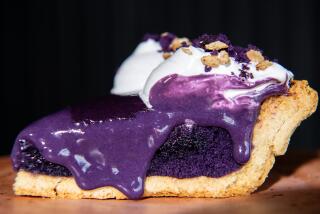Granny Smith and the Wedge
- Share via
One of the most beloved American dessert traditions is warm apple pie with a big wedge of sharp Cheddar. There are restaurants that even bake a slice of cheese onto the crust, so you’re guaranteed your serving of cheese with your pie.
Europeans are often astonished by the whole idea of cheese with pie. It seems to them that we’ve fused the dessert course with the cheese course, two separate parts of the meal in Europe.
How did we start doing this? The history is a little obscure. The practice is rarely mentioned in cookbooks until about 1950.
The major 19th century American cookbooks certainly don’t mention it, though memoirs of life in the upper Midwest indicate that cheese was already a regular accompaniment to warm apple pie there before the turn of the century. The upper Midwest is major dairy country, of course, and it’s still where the custom is liveliest.
Conceivably it grew out of the 17th and 18th century English custom of serving pie with a sauce, often dairy-based. This was usually custard sauce (creme anglaise, as we now call it) or hard sauce, but as early as 1828, an American cookbook, Eliza Leslie’s “Directions for Cookery,” was suggesting plain cream. Fannie Farmer and other late 19th century New England cookbook authors regularly suggested cream, whipped cream or ice cream.
How did we get from there to cheese? It may be significant that we rarely, if ever, serve cheese with any pie but apple. Cheese and raw apples are often served together as the end of an informal meal in England and the apples might have been replaced by pie in pie-mad 19th century America.


